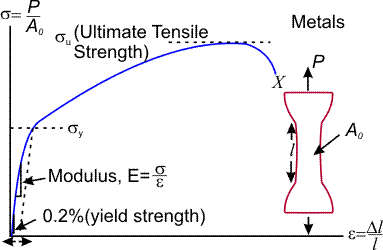| |
Mechanical Properties of Materials
1. Modulus of Elasticity (E):
For a homogeneous and isotropic material, the modulus of elasticity is often obtained by subjecting
a small strip of material to tensile or compressive load in a universal testing machine. The load vs.
deformation data are obtained against a constant strain-rate and the engineering stress-strain
curve is plotted from these data. As shown in the figure below, a part of the stress-strain curve is
linear for most of the materials. The slope of the stress-strain curve at this linear region is defined
as the Modulus of Elasticity, E. The SI unit of E is Pascals (Pa – N/m2). Often, E is quite high in
terms of Pa and hence it is expressed as Giga Pascals or GPa (1 GPa = 109 Pa)

Engineering Stress-Strain Curve for a Ductile Metal showing the Modulus of Elesticity E, 0.2% Yield Strength σy and the Ultimate Tensile Strength σu
The other related properties are Shear Modulus of Elasticity G, and Bulk Modulus of elasticity K.
The relationships between G, K and E are as follows:
Where, ν is the Poisson’s ratio.
Usually, ν = 0.3, hence,
 , and , and

For elastomeric materials: ν = 0.5, hence, G=1/3E and K>>E
|